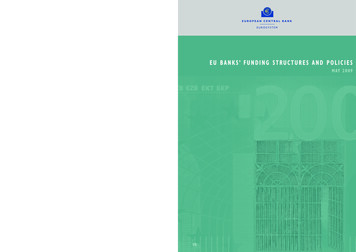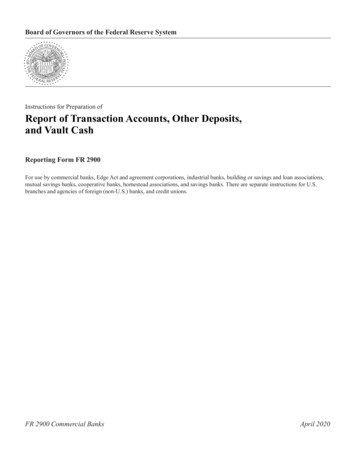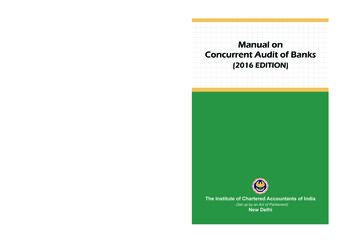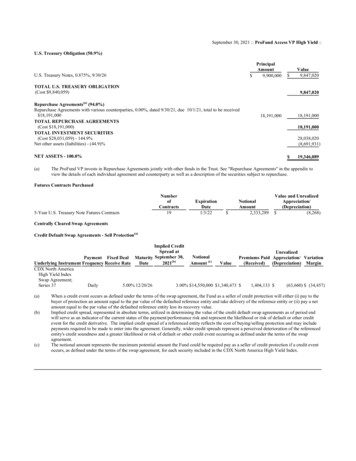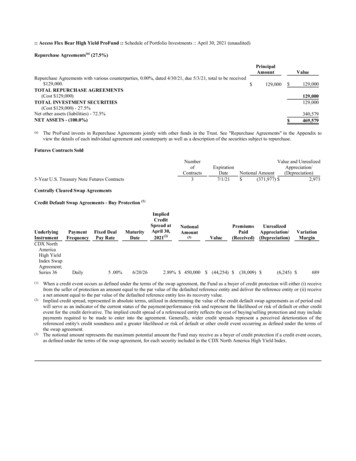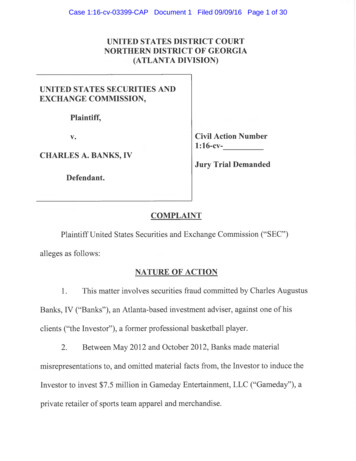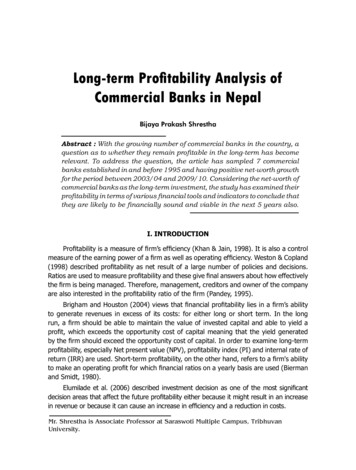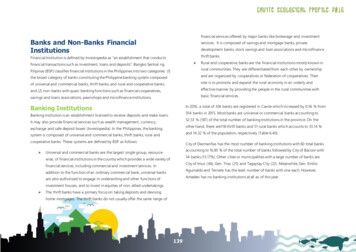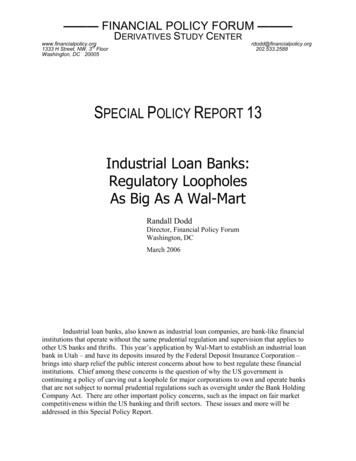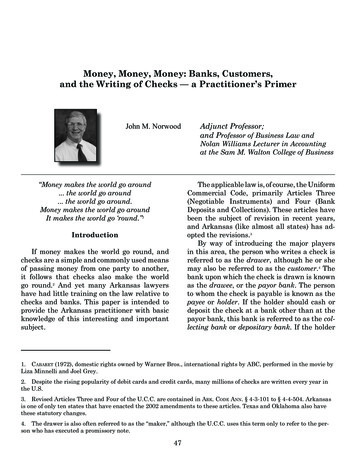
Transcription
Money, Money, Money: Banks, Customers,and the Writing of Checks — a Practitioner’s PrimerJohn M. NorwoodAdjunct Professor;and Professor of Business Law andNolan Williams Lecturer in Accountingat the Sam M. Walton College of BusinessThe applicable law is, of course, the UniformCommercial Code, primarily Articles Three(Negotiable Instruments) and Four (BankDeposits and Collections). These articles havebeen the subject of revision in recent years,and Arkansas (like almost all states) has adopted the revisions.3By way of introducing the major playersin this area, the person who writes a check isreferred to as the drawer, although he or shemay also be referred to as the customer.4 Thebank upon which the check is drawn is knownas the drawee, or the payor bank. The personto whom the check is payable is known as thepayee or holder. If the holder should cash ordeposit the check at a bank other than at thepayor bank, this bank is referred to as the collecting bank or depositary bank. If the holder“Money makes the world go around. the world go around. the world go around.Money makes the world go aroundIt makes the world go ‘round.”1IntroductionIf money makes the world go round, andchecks are a simple and commonly used meansof passing money from one party to another,it follows that checks also make the worldgo round.2 And yet many Arkansas lawyershave had little training on the law relative tochecks and banks. This paper is intended toprovide the Arkansas practitioner with basicknowledge of this interesting and importantsubject.1. Cabaret (1972), domestic rights owned by Warner Bros., international rights by ABC, performed in the movie byLiza Minnelli and Joel Grey.2. Despite the rising popularity of debit cards and credit cards, many millions of checks are written every year inthe U.S.3. Revised Articles Three and Four of the U.C.C. are contained in Ark. Code Ann. § 4-3-101 to § 4-4-504. Arkansasis one of only ten states that have enacted the 2002 amendments to these articles. Texas and Oklahoma also havethese statutory changes.4. The drawer is also often referred to as the “maker,” although the U.C.C. uses this term only to refer to the person who has executed a promissory note.47
ARKANSAS LAW NOTES 2011should either cash or deposit the check at acollecting bank the check will be sent to thepayor bank through the check collection system. The routing of checks is automatic andutilizes the MICR (Magnetic Ink CharacterRecognition) number printed on the bottomof all checks. Got it? Then let s begin!appeal to the Maryland Supreme Court thedefendant bank again prevailed, the courtstating that Aabsent a special relationship,a non-customer has no claim against a bankfor refusing to honor a presented. check.@8The court discussed the old English case ofBoard of Inland Revenue v. Haddock (knownas the Anegotiable cow@ case) in which a disgruntled taxpayer wrote a check on the sideof a cow. The collector of taxes attempted toendorse and deposit the check, but the cowAappeared to resent endorsement and adopteda menacing posture,@ at which point the collector refused to accept the check. Accordingto the story, the taxpayer was subsequentlyarrested in Trafalgar Square for causing anobstruction. Sadly, the court noted that thiscase never actually happened. It was reported in Punch Magazine and has been repeatedmany times, thus taking on the stature oftruth.A class action case illustrating the application of this basic legal principal isKronemeyer and Johnson v. U.S. BankNational Association,9 in which the IllinoisCourt of Appeals dismissed a class action lawsuit against a bank which charged a 10 feeto non customers who wished to cash checksdrawn by the bank s customers.10 In a similarcase involving the use of ATM machines, theDuty of the payor bankto pay on a checkWhen a customer (drawer) issues a checkthe payor (drawee) bank is under an obligation to the customer to pay the check provided there are funds available and the check isproperly payable.5 It is important to note thatthis obligation is owed only to the customerand not to the holder (payee) of the check.An interesting case illustrating this point isMessing v. Bank of America.6 In this case theholder presented a 976 check to the payorbank which declined to pay based on theholder s refusal to submit to a Athumb printsignature@ required of all non customer holders.7 Messing sued, claiming that the bank’srefusal was a violation of its obligations under the Uniform Commercial Code. The trialcourt issued a summary judgment in favorof the payor bank, and this ruling was affirmed by the Maryland Court of Appeals. On5. Ark. Code Ann. §4-4-402 (2011).6.821 A.2d 22 (Md. 2003).7. The holder could have avoided litigation (and preserved the sanctity of his thumb) simply by depositing thecheck in his own bank, which would have sent the check to the Bank of America and payment would have routinelybeen made. Evidently this holder preferred the joy and excitement associated with civil litigation.8.821 A.2d at 33.9.857 N.E.2d 686 (Ill. App. 2006).10. The court stated that U.C.C. 4-402 confers “no cause of action on the holder of an allegedly dishonored item.”48
MONEY, MONEY, MONEYCourt of Appeals for the Sixth Circuit ruledthat a bank had the legal right to charge noncustomers two dollars for withdrawals fromtheir ATM machines.11Although the payor bank owes no duty toholders, there is most definitely a duty owedto customers, and in cases where the payorbank violates its duty to pay a check whichis properly payable, the customer is entitledto recover damages proximately caused.12 Inmost cases the damages are negligible, asthe bank will be quick to notify check holders that the return of the item was due to anerror by the bank, to be promptly corrected.However, in a few cases courts have upheldsubstantial jury awards. One such case isGoldsmith Motors Corp. v. Chemical Bank.13In this case a New York appellate court upheld a jury verdict in favor of the customerin the amount of nearly 3 million, including 2.3 million for injury to reputation and business and 600,000 for lost profits. The caseinvolved a series of wrongful dishonors overan eight month period, allegedly resultingin a lowering of the morale of the customer’semployees and causing the customer’s partssuppliers to require cash on delivery.In the past twenty five years there havebeen a few Arkansas cases on this point.Perhaps most interesting is the case of TwinCity Bank v. Isaacs.14 In this case the cus-tomer discovered the checkbook was missingand reported the loss to the bank. The banksubsequently honored two checks which contained forgeries, after which they denied access to the checking account for four years, onthe basis of their suspicion that the customerwas involved in the forgery. Applying U.C.C.4-402, the Arkansas Supreme Court upheld ajury award in the amount of 18,500 in compensatory damages and 45,000 in punitivedamages. In so doing the Court rejected arguments regarding jury misconduct, failureof the trial judge to give certain requestedinstructions, and the unreasonable natureof the award. The Court held that the jury’saward of damages for mental suffering wasauthorized by the Code, even though suchdamages were seldom awarded in prior cases.15 The court also held that no higher proofwas required in order to prove mental suffering.In the case of City National Bank v.Goodwin,16 the bank had two customers withthe same first and last names, and one of thetwo had a loan in default. As a result of confusion the bank erroneously refused to pay onchecks written by the solvent customer. Interalia the jury awarded compensatory damagesof 10,000 and punitive damages of 30,000.The trial judge allowed the jury’s verdict tostand, but on appeal the Supreme Court over-11. Clemmer v. KeyBank, 539 F.3d 349 (6th Cir. 2008).12.Ark. Code Ann. § 4-4-402 (2011).13. 838 N.Y.S.2d 631 (New York 2007).14. 672 S.W.2d 651 (Ark. 1984).15. A higher burden of proof was held to apply.16. 783 S.W.2d 335 (Ark. 1990).49
ARKANSAS LAW NOTES 2011turned the award for punitive damages, stating that there was no evidence of intent orbad faith on the part of the bank. The Courtstated that:pay the check, provided payment is made “ingood faith.” A case illustrating this principle isIBP v. Mercantile Bank,20 decided by a federaldistrict court in 1998. In this case the payeesomehow misplaced a check in the amount of 135,234.18, finding it nine years later.21 Thecheck was deposited in the payee s account ata collecting bank, and was presented to thepayor bank via the normal check collectionprocedure. The payor bank s computerizedprocessing system then paid the check andcharged the customer s account. In the ensuing lawsuit the customer claimed that thebank had a duty to ascertain whether a checkwhich had been outstanding for so long continued to represent a legal obligation of thecustomer. The court disagreed, stating thatAabsent circumstances that reasonably put abank on notice of an instrument s invalidity,the bank is not responsible for investigating whether checks written on its customer’saccounts represent outstanding obligationsbefore paying them.@22 It is relevant to notethat the MICR system, upon which the entirebanking system relies for proper routing ofchecks, does not include any information regarding the date on a check. It is also important to note that most banks do not physicallyexamine checks which are received throughthe check collection process, and are not required to do so under the U.C.C. . . the act of conversion in itself willnot support an award for punitivedamages. Instead, the plaintiff mustshow that the defendant intentionallyexercised control or dominion over theplaintiff’s property for the purpose ofviolating his right to the property orfor the purpose of causing damages.17Finally, in the case of Gordon v. Planters& Merchants Bankshares, Inc.18 the ArkansasSupreme Court held that punitive damagescould be awarded against a collecting bankfor wrongful and malicious charge back of adeposited item. The case is distinguishablefrom the cases previously discussed as it didnot involve actions by a payor bank.Stale checksOnce a check has been outstanding formore than six months it is regarded asAstale.@19 Contrary to common belief, this doesnot mean that the check cannot or will not bepaid; it merely removes the obligation whichthe bank owed to its customer to pay a properly payable check. A bank may, if it wishes,17. 783 S.W.2d at 338.18. 935 S.W.2d 544 (Ark. 1996).19.Ark. Code Ann. § 4-4-404 (2011).20. 6 F. Supp. 2d 1258 (U.S. Dist. Kan. 1998).21. This seldom happens to me.22. 6 F. Supp. 2d at 1266.50
MONEY, MONEY, MONEYer of a 4,100 personal (not cashier’s) checkpresented the check to the payor bank butwas told that there were insufficient funds.The next day the issuer of the check stoppedpayment. Five months later the holder againpresented the check to the bank and askedfor a cashier s check in return. An employeeof the bank (apparently being unaware of thestop payment order on the personal check)indicated that funds were available, and thebank issued a 4,100 cashier s check to theholder. When the bank realized its error itnotified the holder that it intended to dishonor the cashier s check. In the ensuing litigation the Colorado Supreme Court held for theholder, stating that Aonce the bank issues anddelivers the cashier s check to the payee, thetransaction is complete as far as the payee isconcerned.@26Similar results have obtained in cases decided in Ohio and New Jersey.27 In the NewJersey case the court reiterated the doctrinethat Abecause a cashier s check carries theimprimatur of the financial institution thatissues it, this instrument is viewed in thecommercial marketplace as the functionalequivalent of cash.@28 The facts of the case involved a complex series of transactions whichresulted in a bank issuing a cashier s checkeven though its customer did not have suffi-Post-Dated ChecksThe current version of the U.C.C. effectively negates the formerly popular practiceof a debtor issuing a post-dated check (checkupon which is written a date in the future)with the objective of delaying the creditor sright to collect on the instrument. Under current law such an instrument may be paid bythe bank as soon as the instrument is presented without regard to whether the dateon the check has arisen unless the customerhas given notice to the bank describing thecheck with reasonable certainty.23 Such notice would have all of the characteristics of aAstop payment order@ and of course would besubject to a fee for the service.Cashier’s ChecksThe current version of the U.C.C. definesa Acashier s check@ as a draft in which thedrawer and the drawee are the same bankor branches thereof.24 By issuing a cashier scheck the bank assumes primary liability forthe amount of the check and barring veryunusual circumstances is absolutely liableon the instrument. A good example of thisis the case of Flatiron Linen, Inc. v. FirstAmerican State Bank.25 In this case the hold-23.Ark. Code Ann. § 4- 4-401(c) (2011).24.Id. at § 4-3-104(g).25. 23 P.3d 1209 (Col. 2001).26. 23 P.3d at 1213, citing Kaufman v. Chase Manhattan Bank, 370 F. Supp. 276 (S.D.N.Y. 1973), a case decidedunder the prior version of the Code.27. National City Bank v. Citizens National Bank of Southwest Ohio, 55 U.C.C. Rep. Serv. 2d 233 (Ohio App.2004), Parks v. Commerce Bank, 57 U.C.C. Rep. Serv. 2d 576 (N.J. Super. 2005).28. 57 U.C.C. Rep. Serv. 2d at 576.51
ARKANSAS LAW NOTES 2011cient funds on deposit to cover the amount ofthe check. In holding the bank responsible forthe amount of the cashier s check, the courtstated that Athe issuer of a note or cashier scheck or other draft drawn on the drawer isobliged to pay the instrument according toits terms at the time it was issued.@29 This issometimes referred to as the “cash equivalent” doctrine, and is widely (although notuniversally) accepted by courts.However, Comment 3 to section 4-3-411suggests that if the payee or holder of the cashier’s check is not a holder in due course, thebank that issued the cashier’s check does notneed to pay if the bank has itself a defense orclaim. If courts follow this comment, they maydiminish the cash nature of cashier’s checks.Remember that comments in the Code arenot the law and are written by a few people.Sometimes work on the comments continuesafter the American Law Institute approvesthe proposed uniform law.30Exceptions to the Acash equivalent@ doctrine are few and far between and are usuallybased on very unusual facts. One such caseis Trump Taj Mahal Associates, LLC v. TheBank of New York.31 In this case a patron of anAtlantic City casino faxed a copy of a teller scheck to the Taj Mahal prior to his arrival.The check was in the amount of 370,208.After the gambler concluded his (unsuccess-ful) visit, the casino deposited the check, andwhen it was received by the payor back itwas stamped Apaid@ without an inspection.It turned out that the original amount of thecheck was 1,040, but the amount had beenaltered by the patron/gambler. In the lawsuitthe Taj Mahal argued that the stamping ofApaid@ on the check was an acceptance, but thecourt ruled that Ait was simply an evidence ofinternal processing, which defendant couldand did cancel. . . .@32Although the cash equivalent doctrinemeans that payment cannot be stopped on acashier s check, there is a remedy availableto the procurer of a cashier s check in theevent that the check is lost or stolen. In sucha case the procurer may notify the bank thatthe item has been lost or stolen. Accordingto the Code, this notification is made underpenalty of perjury.33 However, this claim willnot be enforceable for ninety days (the 90 dayrule) during which time the rightful owner ofthe check may collect from the payor bank.Payment to the rightful holder discharges thebank’s liability on the instrument. Accordingto the Official Comment, Athus, if a lost checkis presented for payment within the 90 dayperiod, the bank may pay a person entitled toenforce the check without regard to the claimand is discharged of all liability with respectto the check.@3429. 57 U.C.C. Rep Serv. 2d at 581.30. But see the comment to § 4-3-411, which does not seem to fully support the cash equivalent doctrine.31. 61 U.C.C. Rep. Serv. 2d 77 (N.J. Super. 2006).32. 61 U.C.C. Rep. Serv. 2d at 81.33.Ark. Code Ann. § 4-3-312.34.Id. at § 4-3-312, Comment 3.52
MONEY, MONEY, MONEYor other expeditious means.37 The midnightdeadline also applies to situations where thepayee has an account at the same bank as thecustomer (payor bank) and deposits the checktherein.Suppose that a payor bank cashes a checkonly to realize later that the payment wasmade by mistake? For example, assume thatafter cashing a check the bank realizes thattheir customer s account is insufficient to paythe check. Can the bank demand that theholder return the money? One might thinkthat this is legally impossible, since paymentby the bank concludes the transaction, butsuch is not always the case. The U.C.C. permits the payor bank to recover payment fromthe holder who cashed the check if and only ifthe holder did not receive the instrument ingood faith and for value. This portion of theCode is based upon common law principles ofmistake and restitution; the purpose of thisrule is to avoid unjust enrichment.38 For instance, assume that Allen receives a 5,000check from his uncle as a birthday present.Allen presents the check to the payor bank andthe bank cashes the check, not realizing thatthe uncle had closed out the account. SinceAllen did not receive the check Afor value@ thebank is entitled to recover the 5,000 in orderto avoid unjust enrichment. This would nothave been the case if, for instance, Allen hadreceived the check for services rendered.When a Payor Bank BecomesLiable on a CheckThe payor bank becomes liable on a checkwhen it either pays the check or fails to returnthe check by the Amidnight deadline@ (midnight of the next business day).35 By way of illustration, assume that the holder of a 1,000check enters the payor bank and cashes thecheck. At the moment that the money is givento the holder, the bank becomes liable on thecheck and can do no more than charge theircustomer s account. If, however, the holderdeposits the check at his or her own bank (thecollecting bank) the check will be sent to thepayor bank through the normal check collection process. When the payor bank receivesthe check they will be deemed accountablefor the check if they do not return it to thecollecting bank prior to midnight of the nextbusiness day (the midnight deadline). For example, if a payor bank receives a check at 11a.m. on Monday, they must return the checkby midnight Tuesday or they will be deemedaccountable for the check.36 The midnightdeadline has been modified to some extentby Regulation CC, found in CFR Sections229.30-229.43. The effect of this regulationis to extend the midnight deadline in certainsituations designed to encourage payor banksto abandon the practice of returning dishonored checks by mail in favor or using couriers35.Id. at § 4-4-215.36. Banks have an established cut-off time after which time a check will be deemed to have been received the nextday. For instance, if the cut-off time is 3:00 p.m., a check which is received at 4 p.m. on Monday will be deemed tohave been received on Tuesday, and the midnight deadline will be midnight Wednesday.37. See John Norwood, The Impact of Federal Regulations on the U.C.C. Midnight Deadline, 125 The Banking LawJournal, No. 9, p. 817 (2008).38.Ark. Code Ann. § 4-3-418 (2011).53
ARKANSAS LAW NOTES 2011Stop Payment Ordersrect. At that time the bank s computerizedsystem flagged checks by amount only, andas a result the bank paid the check despitethe stop payment order. The customer suedthe bank, arguing that the bank s employeetold him that payment would be stopped,and did not say anything about requiring theexact amount in order to stop pay. The juryruled in favor of the customer, and this wasaffirmed by the Court of Appeals. The courtrejected the bank s argument that the failureof the customer to provide the exact amountshould excuse the bank s actions. The courtstated that stopping payment was a serviceexpected by customers, and that Athis argument, if allowed to prevail, would be inconsistent with the intent of the General Assemblyin enacting (U.C.C. 4-403).42In a 1999 case decided by the FederalSeventh Circuit Court of Appeals the bankwas able to prevail on the Areasonable opportunity to act@ argument. The case wasRovell v. American National Bank.43 In thiscase the customer, a practicing attorney, engaged the services of a private investigator.He sent a check to the investigator for services rendered, but quickly realized that theamount of the check was 10,000 higher thanthe amount of the debt. The attorney then attempted to stop payment. The conversationbetween the attorney and the bank s representative was remembered differently by theparties, but apparently the attorney was notUnder the U.C.C. a customer may stoppayment of any item drawn on the customer’saccount, but the order must describe the itemwith reasonable certainty and be received atsuch time and in such manner as to afford thebank a reasonable opportunity to act on it.@39An oral stop payment order is good for fourteen days and a written stop payment orderis good for six months. The six month timeperiod is of course associated with the stalecheck time period, but what is often forgottenis the fact that a bank has a legal right to payon a stale check. Hence, the holder of a checksubject to a stop payment order may presentthe check after the six month period, and unless the bank notices the date the check willprobably be paid. Thus, an extremely cautious customer may wish to renew a stop payment order for a second or even a third timeto feel fully protected.40The Code provides that a bank must havea reasonable opportunity to act on a stop payment order. In 1987 the Arkansas Court ofAppeals had occasion to rule on what constitutes Areasonable opportunity.@ In First StateBank of Warren v. Dixon41 a customer attempted to stop payment on a check which was inthe amount of 1,868.15. Unfortunately thestop payment order incorrectly listed theamount as 1,828.73. The account number,check number, date, and payee were all cor-39.Id. at § 4-4-403.40. Recall that in the Mercantile Bank case, note 20, the bank was held to be justified in paying a check which wasnine years old. In this case not even eighteen stop payment orders would have been sufficient to protect the customer.41. 728 S.W.2d 192 (Ark. App. 1987).42. 728 S.W.2d at 193.43. 194 F.3d 867 (7th Cir. 1999).54
MONEY, MONEY, MONEYcertain of the number of the check in question, and a stop payment order was issued applicable to checks 1084 and 1086. The bank srepresentative testified that she was not surewhether she told the customer that the checknumber was essential to stopping payment,but she was certain that she cautioned thecustomer not to write checks immediately after a stop payment order.As it turned out the correct check numberwas 1105, and when the check was received ashort time later the bank paid it. Meanwhile,the attorney issued a new check to the private investigator for the correct amount. Thischeck was also cashed.44 However, the attorney was totally unaware of any problem evenupon receiving his bank statement, as he apparently did not open the statement for manyweeks.Not long afterward the attorney filed forbankruptcy,45 leaving it up to the bankruptcycourt to determine whether the bank shouldbe responsible to the attorney’s estate for failing to stop payment. The bankruptcy courtheld that the bank had no responsibility forwhat had transpired, and this was affirmedby the appellate court. The court held that itwas unreasonable for the attorney to send areplacement check to the private investigator knowing of an uncertainty regarding thecheck number and after an explicit warningfrom the bank that it would be prudent towait a few days.4644.Surprised?45.Surprised?A final important point regarding stop payment orders is that a bank which has improperly paid on a check despite the existence ofa stop payment order is not absolutely liableto the customer for this failure; instead, “theburden of establishing the fact and amountof loss . . . is on the customer.”47 This rule isintended to prevent unjust enrichment. Forexample, if a customer pays for merchandisewith a check and without any justification issues a stop payment order, a bank which inadvertently pays the check may charge thecustomer s account, as the check representeda lawful debt of the customer. An interestingcase illustrating this point is Seigel v. MerrillLynch.48 In this case the customer issued twochecks (markers) to New Jersey casinos totaling over 140,000. Upon returning homehe endeavored to avoid his gambling debts bystopping payment on the checks. The bankerroneously paid the checks. Applying thelaw of New Jersey, the court ruled that thesechecks represented legal obligations owed thecasino, and the bank was subrogated to thoserights. The court stated that Aeven if paymenthad been stopped, the casinos could have enforced the checks in New Jersey where thetransaction was entered into. Merrill Lynch(the payor bank) therefore, under the Codescheme, conceptually has the same right.@4946. An interesting aspect of the decision is that the court based its decision on basic principles of contract and tortlaw; the U.C.C. was never cited.47.Ark. Code Ann. § 4-4-403(c) (2011).48. 745 A.2d 301 (D.C. App. 2000).49. 745 A.2d at 306.55
ARKANSAS LAW NOTES 2011to Mexico. After their vehicle broke down, itwas determined that Haile would return totheir apartment to arrange for the fixing of thecar. A few weeks later Haile decided to moveto another apartment, and from Mexico thecustomer indicated to Haile that she wishedto continue to reside with Haile, who wasgiven permission to move her things, including her checkbook, to the new location. Hailethen took three checks from the customer scheckbook, forged the customer s signatureon the checks, and the payor bank paid thechecks. Haile then departed with the money.The customer did not realize what had happened until she returned from Mexico. Sheclaimed that the payor bank had no right topay on these forgeries.In the ensuing litigation the payor bankargued that although they paid on forged instruments the customer was liable as a result of a failure to exercise ordinary care. Thecourt agreed with the bank s argument. Thecourt stated that the customer Afailed to adequately investigate her roommate, movingin after knowing Haile only briefly, and lefther checkbook in the apartment unattended.Plaintiff s failure to adequately secure andmonitor her checks afforded an opportunityof which advantage (was) in fact taken. @53Another case illustrating negligence isWilliams v. Montana State Bank,54 in which acon man persuaded the drawer to allow himto repair her lightening rod for a charge ofonly 1.26. He convinced the woman to giveLiability for ForgeriesAlthough the law regarding liability forforgeries can be somewhat complex in certainsituations, the basic rule is easily stated: aforgery is not considered a legal signature,and a payor bank which pays on a forgery isstrictly liable to the customer.50 For example,if a customer s checkbook is stolen and thethief writes out a check (forging the drawer ssignature), payment of the item by the payorbank would result in a loss to be sustained bythe bank. This is true even though the forgery was so similar to the real signature thatdetection by the payor bank was virtually impossible.The primary exception to this basic principle is covered in U.C.C. 3-406 in which it isstated that Aa person whose failure to exerciseordinary care substantially contributes to analteration of an instrument or to the makingof a forged signature on an instrument is precluded from asserting the alteration or forgery against a person that, in good faith, paysthe instrument or takes it for value.@51A classic example would be a person who writes acheck leaving spaces in the amount section,making alteration easy and undetectable.Another example can be found in an interesting case from Ohio. In Jurcisin v. Fifth ThirdBank,52 the customer moved to a new city andwas introduced to a woman (Farris Haile)from whom she rented an apartment. A fewmonths later the two women took a road trip50.Ark. Code Ann. § 4-3-403 (2011).51.Id. at § 4-3-406.52. 857 N.E.2d 1265 (Ohio Misc. 2006).53. 857 N.E.2d at 1266, citing G.F.D. Ents, Inc. v. Nye, 525 N.E.2d 10 (Ohio 1988).54. 534 P.2d 1247 (Mont. 1975).56
MONEY, MONEY, MONEYhim a blank check whereon he wrote theamount as 1.26, but left spaces on the checkmaking alteration easy. The woman thensigned the check, apparently without noticing the spaces thereon. The con man thenraised the amount to 6,841.26 and cashedthe check at the payor bank. In reversing thetrial court, the Montana Supreme Court heldfor the bank, finding that in addition to signing the check with spaces, the customer alsofailed to put in the name of the payee and didnot ask for a business card or other authorization. The totality of her conduct constitutednegligence. However, in a very similar casein Texas a different outcome occurred. In Rayv. Farmer’s State Bank55 an eighty year oldcustomer was induced to issue a 1.50 checkto a scam artist with spaces left on the check.The lower court held in favor of the customer,and this was upheld by the Texas SupremeCourt. The court held that there was at leastenough evidence to create a question of factregarding the negligence of the customer;the woman was awakened from a nap, did atleast ascertain the amount of the check andthat it was written in ink, and attempted totelephone the bank. It is possible that a f
Messing v. Bank of America.6 In this case the holder presented a 976 check to the payor bank which declined to pay based on the holder s refusal to submit to a Athumb print signature@ required of all non customer hold-ers.7 Messing sued, claiming that the bank's refusal was a violation of its obligations un-der the Uniform Commercial Code.
